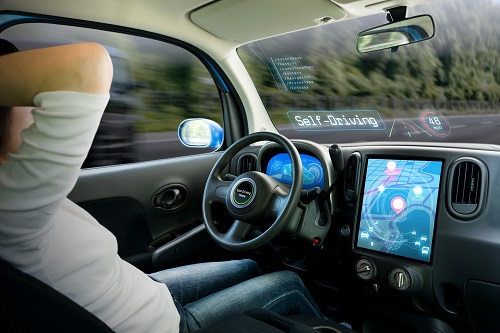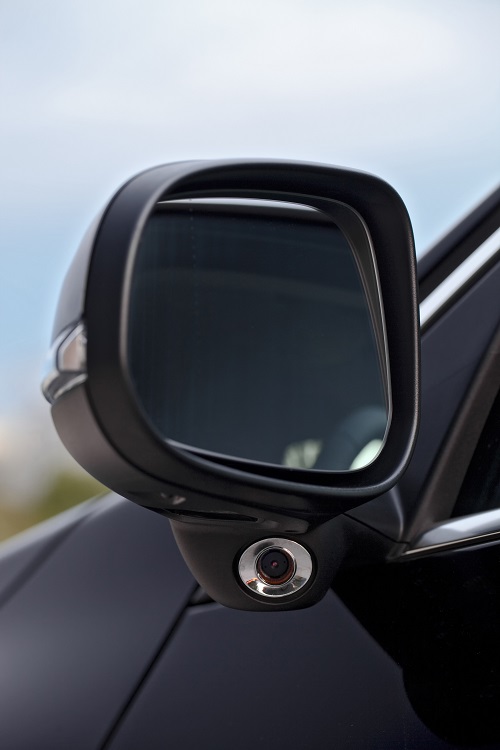BY ROLAND DORN, Director, Serial Links, Automotive Business Unit
Maxim Integrated Inc.
www.maximintegrated.com
Future cars promise to be hubs of activity inside; some passengers might engage in a video conference call for work, while others stream a movie or play video games. And the promise of autonomous vehicles leads to a safer, more efficient ride. Automotive OEMs and suppliers already recognize the fact that ADAS and infotainment applications can help them differentiate their vehicles and brands.
Cars have already evolved from having single-function, low-resolution displays to boasting rear-facing cameras and high-resolution displays. Looking ahead, we could see vehicles with more than a dozen cameras, several high-definition displays, and multiple serial links to transport all of the data. According to Strategy Analytics, bandwidth requirements are projected to increase by a factor of roughly 25 from 2017 to 2020. That, in turn, will lead to higher frame rates and resolutions.
High bandwidth, interconnect complexity, and data integrity — these are some of the critical challenges that high-speed serial links must address. What’s more, serial link technology must perform well in the harsh operating environment in a vehicle while delivering the speed, reliability, and low latency to push voluminous amounts of data to trigger real-time responses.

Fig. 1: Self-driving capabilities will require faster data rates and more bandwidth inside vehicles. Image Credit: Shutterstock.
ADAS fuels a safer ride
Pedestrian and traffic sign detection, lane departure warning, driver drowsiness detection, and collision avoidance are just a few of the safety functions that are either already available or are in development and refinement for today’s cars. Regulatory pushes toward increased safety are driving the popularity of some of these applications. The United States and the European Union, for instance, are mandating that by 2020, all vehicles must have systems for autonomous emergency braking and forward-collision warning.
The ADAS applications rely on input from various sensors, including radar, lidar, and cameras. After the data from these sensors is collected, it must be processed in real time by sophisticated software algorithms running on a microcontroller unit (MCU) or electronic control unit (ECU). Based on the resulting output, the vehicle takes some corresponding action or alerts the driver to do so.
Vehicular camera systems, in particular, boast very high data rates. In a surround-view system, for example, each camera typically has a video stream with 1,280 x 800 pixel resolution and a frame refresh rate of 30 fps. In addition, every IC on a camera module must be able to perform reliably under stringent temperature ranges and different environmental conditions over the life of the vehicle.
Another important consideration is the limited space in a vehicle. Even though there’s an increasing number of in-car camera systems, vehicles themselves aren’t increasing in size to accommodate the additional components. As a result, automakers are looking to make these systems more compact and also lower the cost.

Fig. 2: Blind-spot detection is one of many ADAS applications that require real-time processing of data inside the vehicle.
Enrich infotainment systems
With multimedia content, communications, navigation, and the convenience of touchscreens and even voice control, infotainment systems are helping to enrich the driver and passenger experience. Such systems are complex and distributed, accessing functionality from different in-vehicle control units and processing the information from these varied sources in parallel.
Peek deep inside a car and you’ll find a variety of established bus systems that transfer data between components. The MOST protocol links the components of the infotainment system with different audio amplifiers, tuners, and CD/DVD changers. CAN buses perform the communications for functions that deliver comfort and convenience.
Previously common, simple high-speed video transmission has evolved into a technology that supports audio and video signals along with control channels. To enable in-vehicle audio, video, and communications, automakers rely on high-speed serializer/deserializer (SerDes) line drivers and receivers that deliver high bandwidth, performance, and reliability.
V2V and V2X communications
With wireless vehicle-to-vehicle (V2V) and vehicle-to-everything (V2X) communications, cars can talk to each other as well as to static objects on the road, such as traffic signals. These technologies enable vehicles to broadcast to one another their position, speed, brake status, and other useful data. With these capabilities comes the hope of increased safety as well as efficiency, particularly in areas like fleet management, fuel usage, traffic flows, and even parking.
In spring 2016, about a dozen mostly autonomous and Wi-Fi-enabled trucks drove themselves across Europe as part of the European Truck Platooning Challenge. In truck platooning, the vehicles follow one another at less than one second apart, with goals of improving traffic safety and traffic flow, reducing CO2 emissions, and lowering fuel consumption.
The V2V and V2X systems are significant parts of the underlying technology for platooning, and they require high levels of bandwidth and data integrity.
Bandwidth for tomorrow’s cars
An Ethernet backbone is fairly common in today’s cars, and many OEMs utilize this existing backbone when they need to add a new function, like new cameras, to their next design. Ethernet provides a bidirectional and packetized system that can transport data over a link 100 times faster than a CAN bus, making it useful for mid-level bandwidth communications in applications like navigation systems and control.
With Ethernet, the video feed does need to be compressed at the source and then decompressed at the destination. A CAN bus, on the other hand, is more suited to lower-bandwidth communications because it operates at speeds under 1 Mbps.
As vehicles continue to grow more sophisticated, they will be expected to handle megapixel resolution images, and for that, they will have to tap into high-speed links. With more electronics being integrated into vehicle head units, automakers will also want to continue freeing up space where they can and decrease the power budget currently used by head units. Suffice it to say, many of the serial link technologies currently available aren’t up to the job.
Faster data rates at lower cost
The Gigabit Multimedia Serial Link (GMSL) SerDes technology from Maxim Integrated fully supports the high-bandwidth, complex interconnect, and data integrity requirements for infotainment and ADAS designs. It simultaneously transports HD video, audio, control information, aggregated sensor data, and Gigabit Ethernet over 15 m of a single coaxial cable or 10 m to 15 m of shielded-twisted pair cabling. The GMSL SerDes also meets the stringent automotive electromagnetic compatibility (EMC) specifications.
Because the technology uses coaxial and shielded-twisted pair cables, it mitigates what would otherwise be a complex interconnect backbone and can support video multi-streaming at lower system cost. It supports 4K video, audio, sensor data aggregation, and Gigabit Ethernet traffic. And because it doesn’t require compression, GMSL can support the machine vision technology that many safety features rely upon.
As an example of how GMSL technology can simplify an automotive design while saving space and power, take the case of Maxim’s radio tuner chipset, which features a 14-bit GMSL serializer and a 14-bit GMSL deserializer. The resulting architecture simplifies the design of the head unit and provides better radio signal quality along with lower cost and power consumption. And by serializing the output of the tuners with GMSL links, this architecture reduces the amount of cables needed.
Summary
Cars of the future need higher bandwidth and reliability along with low latency to support data-intensive ADAS, infotainment, V2V, and V2X applications. Here, SerDes technology is poised to facilitate the high-speed data path for various next-generation automotive communications applications.
Advertisement
Learn more about Maxim Integrated





